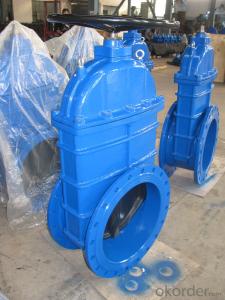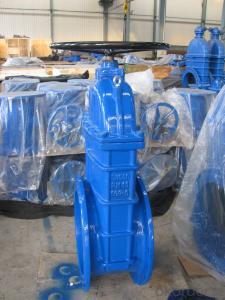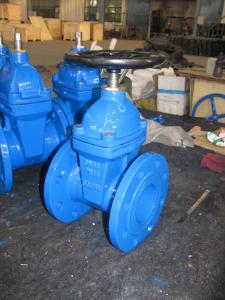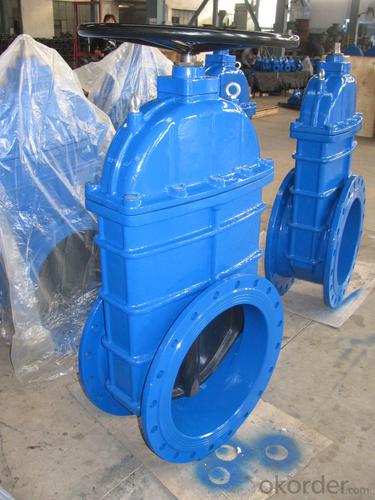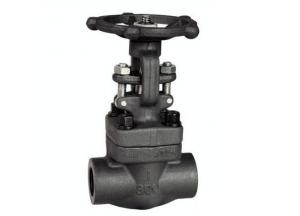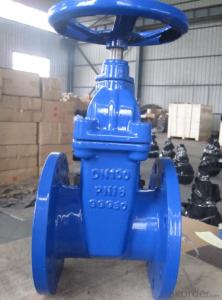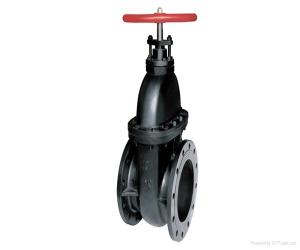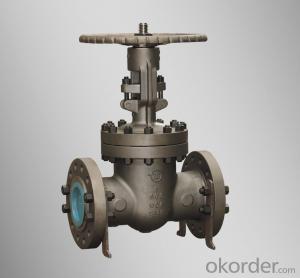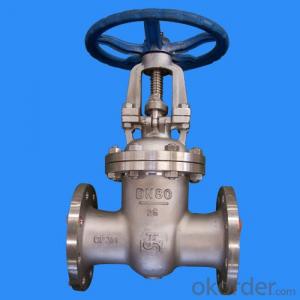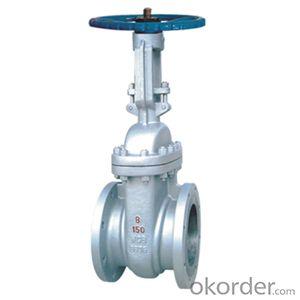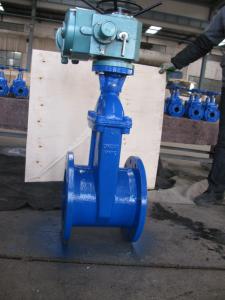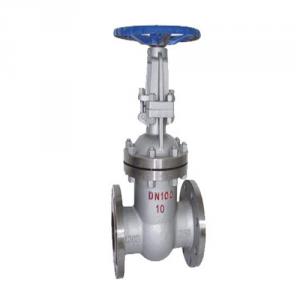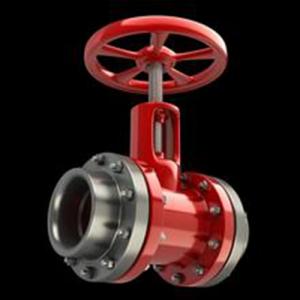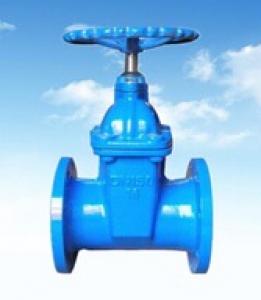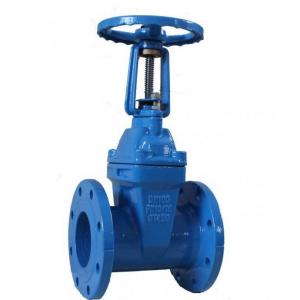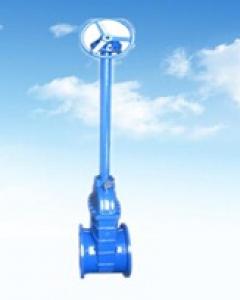Gate Valve ANSI standard 150lbs 300lbs 600lbs 1 1/2
- Loading Port:
- Tianjin
- Payment Terms:
- TT OR LC
- Min Order Qty:
- 200 kg
- Supply Capability:
- 10000 kg/month
OKorder Service Pledge
OKorder Financial Service
You Might Also Like
1.Structure of Gate Valve Description:
A gate valve, also known as a sluice valve, is a valve that opens by lifting a round or rectangular gate/wedge out of the path of the fluid. The distinct feature of a gate valve is the sealing surfaces between the gate and seats are planar, so gate valves are often used when a straight-line flow of fluid and minimum restriction is desired. The gate faces can form a wedge shape or they can be parallel. Gate valves are primarily used to permit or prevent the flow of liquids, but typical gate valves shouldn't be used for regulating flow, unless they are specifically designed for that purpose. Because of their ability to cut through liquids, gate valves are often used in the petroleum industry. For extremely thick fluids, a specialty valve often known as a knife valve is used to cut through the liquid. On opening the gate valve, the flow path is enlarged in a highly nonlinear manner with respect to percent of opening. This means that flow rate does not change evenly with stem travel. Also, a partially open gate disk tends to vibrate from the fluid flow. Most of the flow change occurs near shutoff with a relatively high fluid velocity causing disk and seat wear and eventual leakage if used to regulate flow. Typical gate valves are designed to be fully opened or closed.When fully open, the typical gate valve has no obstruction in the flow path, resulting in very low friction loss.
2. Main Features of the Gate Valve:
• Valve body cavity using non-toxic epoxy resin,both inside and outside flashboard completely is coated with rubber
• Free of water pollution
• High manufacturing accuracy
• High strength
• Environmental protection and energy saving
• Good visual effect
3. Images
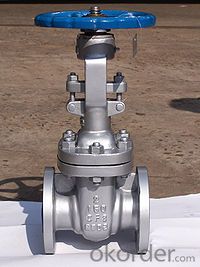
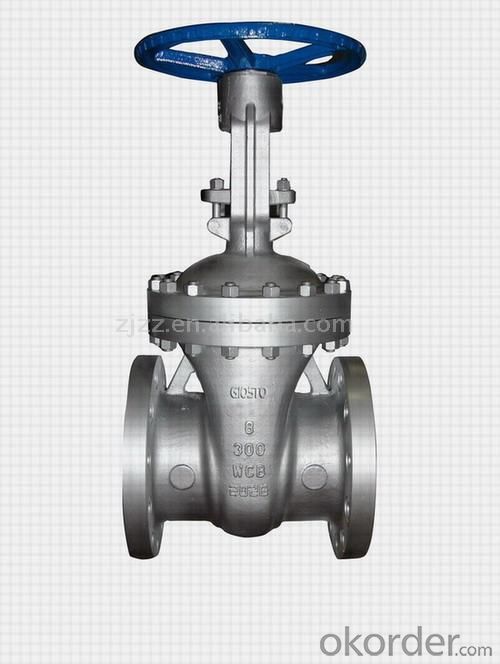
4. Gate valve Specification
1. Size: 1-1/2"-24" (DN40-DN600)
2. Design Standard: BS5150, BS5163, AWWA C509/C515, DIN3202 F4/F5, MSS SP-70.
3. End Flange Connection: ANSI B 16.1, BS EN 1092(PN10, PN16), DIN 2501(PN10, PN16), BS 10 Table E
4. Disc: Grey iron, Ductile iron, with or without EPDM
5. Seat: Stainless steel, Brass/Bronze etc, Soft seat or seal: EPDM, NBR
6. Testing: API 598, ISO 5208
7. Options: Lever, Gearbox operate, Electric actuator, Pneumatic operator, Opening indicator, With limit switch, Others.
8. Type: Non rising stem, Rising stem
9. Finishing: Epoxy coating, Painting etc
10. Usage: Water supply and drainage, Electric power, Petrochemical, Metallurgical, Firefighting / Fire fighting, or other industries.
5.FAQ
1. What's are the characteristics of gate valve?
The distinct feature of a gate valve is the sealing surfaces between the gate and seats are planar, so gate valves are often used when a straight-line flow of fluid and minimum restriction is desired. The gate faces can form a wedge shape or they can be parallel.
2. What is the work principle of gate valve ?
The gate faces can form a wedge shape or they can be parallel. Gate valves are primarily used to permit or prevent the flow of liquids, but typical gate valves shouldn't be used for regulating flow, unless they are specifically designed for that purpose. Because of their ability to cut through liquids, gate valves are often used in the petroleum industry.
3. What is the structure?
Bonnets provide leakproof closure for the valve body. Gate valves may have a screw-in, union, or bolted bonnet. Screw-in bonnet is the simplest, offering a durable, pressure-tight seal. Union bonnet is suitable for applications requiring frequent inspection and cleaning. It also gives the body added strength. Bolted bonnet is used for larger valves and higher pressure applications.
- Q: What are the advantages and disadvantages of flat gate valves?
- The advantage of flat gate valve is that the flow resistance is small, and the flow resistance is similar to the flow resistance of short valve. The flat gate valve with guide hole is installed on the pipeline and can be directly cleaned with the cleaner. As the gate is sliding on the two seat surface, the flat gate valve can be applied to the medium with suspended particles, and the sealing surface of the flat gate valve is actually positioned automatically. The seat seal surface is not subject to thermal deformation of the valve body. Moreover, even if the valve is closed in cold condition, the thermal elongation of the stem will not cause the seal to be subjected to overload. The length of the structure is much shorter than that of the ball valve, and it is easier to start. Light plate gate valve is more refined, but the effect is exactly the same.The disadvantage of flat gate valve is that when the medium pressure is low, the sealing force of the metal sealing surface is insufficient, so as to achieve satisfactory sealing. On the contrary, when the medium pressure is high, if the sealing surface is not lubricated by the system media or foreign media, often opening and closing may cause the sealing surface to wear too much. Another disadvantage is that the circular motion of the circular gate in the circular flow, only when it is at the valve closed position of 50%, this valve is more sensitive to flow control. Moreover, the gate will produce severe vibration when it breaks the high-speed and dense medium flow. The valve seat can also be throttled if the seat is made of a V - shaped opening and is tightly oriented to the gate.
- Q: What are the specifications of the gate valves? Does the work pressure need to be marked separately?
- According to domestic valve model standards, the valve model is by the valve type, gate valve drive mode, gate valve connection, gate valve structure, sealing material, valve body material code to indicate.1, gate valve type code named Z;2, gate valve drive mode code by letters, common 2- electric hydraulic, 9- electric, 6- pneumatic, 5- bevel gear drive, 3- turbo worm; manual do not need to write out;3, gate valve connection form code with letters to indicate, 1- internal thread, 2- external thread, 4- flange type, 6- welding, 7- pairs clamp type, 9- clamp, 0- card sleeve;4, the valve structure of code, 0- flexible wedge, 1- rod single wedge gate valve, 2- rising stem wedge gate valve, 3- parallel single gate valve, 4- parallel double gate valve,
- Q: What does gate valve Z41H-40 mean?
- Z - that means gate valve (the initial letter of Zha)4---- is the connection form, which means flange connection1---- form of structure, which means Plain Bar wedge type rigid single gate valveH---- sealing surface overlaying ferrous carbide (initial letter of alloy steel He)40---- nominal pressure is 40 kg, or 4.0MPa, that is, PN10 at 250 degrees Celsius, the maximum working pressure is 40 kgThe material is cast carbon steel
- Q: Why? God, can you explain to me in detail why?
- The exit of the general pump is the first soft connection (shock absorber), followed by the check valve, and then the partition valve (such as butterfly valve, gate valve, cut-off valve, etc.), this is not the final answer.The question is interesting, and no corresponding information has been found in the relevant standards. We have also discussed the related issues, but differences of opinion is relatively large, the advantages of 1, first installed check valve installed after the valve or butterfly valve, check valve, can be protected, especially in a parallel pump, when the pump does not start, another pump starts when the impact force is gate valve or butterfly valve bear, disadvantages: gate valve or check valve who will protect? There have been a case of butterfly valve is broken. 2, first installed gate valve or butterfly valve installed after the check valve, advantages: can protect the butterfly valve or gate valve, the impact on the check valve to bear. Disadvantages: check valve who will protect, check valve by pressure difference switch, if the high pressure high pressure pipe, pump, if the flow is not stable, so check valve will repeatedly switch, will affect the check valve life. Personal opinion: check valve, check valve performance now have changed, many are using the slow closing check valve, so the impact force is two aspects to bear, because exports are not fully open the valve or butterfly valve, so you can put in check after the gate valve or butterfly valve valve. If not the slow closing check valve installed in the valve or the best after the butterfly.
- Q: Installation and operation instructions of knife gate valve
- 5., when installing the valve, users must reserve the necessary space for valve actuation;The wiring of the 6. driving device shall be carried out according to the wiring diagram;7. knife gate valve must be regularly maintained, shall not be arbitrarily collision and extrusion, so as not to affect the seal.
- Q: What is the wedge type gate valve wedge is what mean
- It can be used on high pressure gate valve. Wedge gate and elastic wedge gate, gate and double gate. A, elastic ram. A circular groove is machined on the vertical bisector surface of the gate so that the gate plate has a certain elasticity. It is this elastic deformation, the gate is closed, the compensation gate sealing surface and the valve seat sealing surface between the wedge angle deviation, the arrival of good agreement, to ensure the sealing. Resilient gate valve sealing surface reliable. Applicable to a variety of pressure and temperature of small and medium-sized gate valve, requiring medium containing solid particles to less, in order to prevent congestion in the gate ring groove, affecting the flexibility of sealing.
- Q: What does valve qz45x - 10q mean?
- Crown valve pressWhat does Q stand for? I'm not sure. It's probably made of ductile iron"Z" means "gate valve"4 represents flange connection5 represents the dark bar (1 represents the Ming pole)X stands for rubber seal and soft seal10q stands for 10 pressure
- Q: What kind of valve is gate valve? Is it different from the cut-off valve?
- Gate valve and the role of the cut-off valve, are playing a role in isolation. The difference is that the gate valve and the cut-off valve are constructed differently. Fluid from the gate valve flow and flow direction is straight, there is no change in direction, but in the cut-off valve is from the bottom of the valve flow into the flow from the upper part of the spool.
- Q: What is an inverted seal gate valve?
- The inverted sealing gate valve is provided with an inverted sealing device, and when the valve is fully opened, an inverted seal is formed, and the filling can be changed under the normal operation of the system.
- Q: Notes on flat gate valves
- internal structureThe 1 seat O ring seal and preload floating seat structure, so that import and export of two-way valve seal plate; and the structure of the normal valve opening and closing torque only 1/2, can easily open and close valves2. when fully open, the channel is smooth and straight, the flow resistance coefficient is extremely small, and there is no pressure loss. The pipeline can be cleaned through the hair bulb3 the packing structure with the ability of self sealing, without frequent adjustment, opening and closing very lightweight, and reliable seal, the stuffing box is arranged at the auxiliary seal oil into the structure, absolutely reliable sealing performance, thereby achieving zero leakage; solve the shortcomings of the general valve packing leakage of the most vulnerable4., when the flat gate valve is closed, it can automatically unload the inner cavity high pressure, and ensure the safe use5., fully enclosed structure, good protection performance, can adapt to all-weather requirements6., the valve seat sealing structure should be elastic, preload, upper and lower sealing seat at the same time sealed structure. The valve seat and the seal are always face to face sealed.The 7. seat has self-cleaning function and is free of direct airflow during valve opening or closing. The seat shall be made of lubricated, non wearing material.8. valve actuator failure will not affect the other parts of the valve, maintenance and replacement work can be carried out without removing the valve.9. yoke sleeve aluminum bronze yoke sleeve with pin type thrust bearing to minimize operation torque.10. stem - thread length until bracket; dowel and spot welding; stability.11. pressure seal - simple construction, with sectional retaining rings and silver plated low carbon steel gaskets, helps to remove and achieve the best bonnet seal.12. seat ring - welded seat ring is perpendicular to the flow channel and is easy to maintain.
Send your message to us
Gate Valve ANSI standard 150lbs 300lbs 600lbs 1 1/2
- Loading Port:
- Tianjin
- Payment Terms:
- TT OR LC
- Min Order Qty:
- 200 kg
- Supply Capability:
- 10000 kg/month
OKorder Service Pledge
OKorder Financial Service
Similar products
Hot products
Hot Searches
Related keywords
